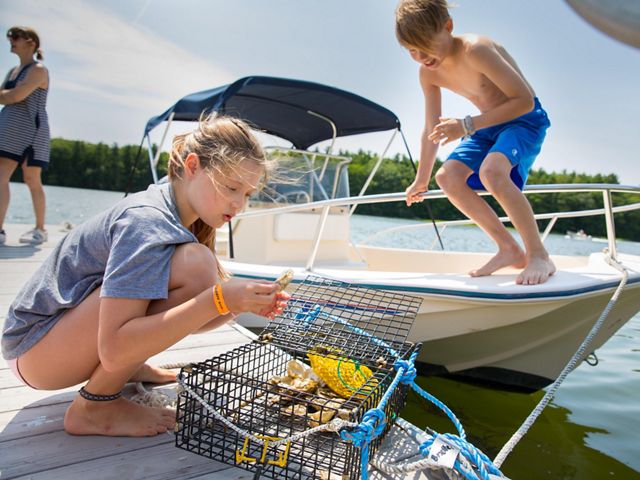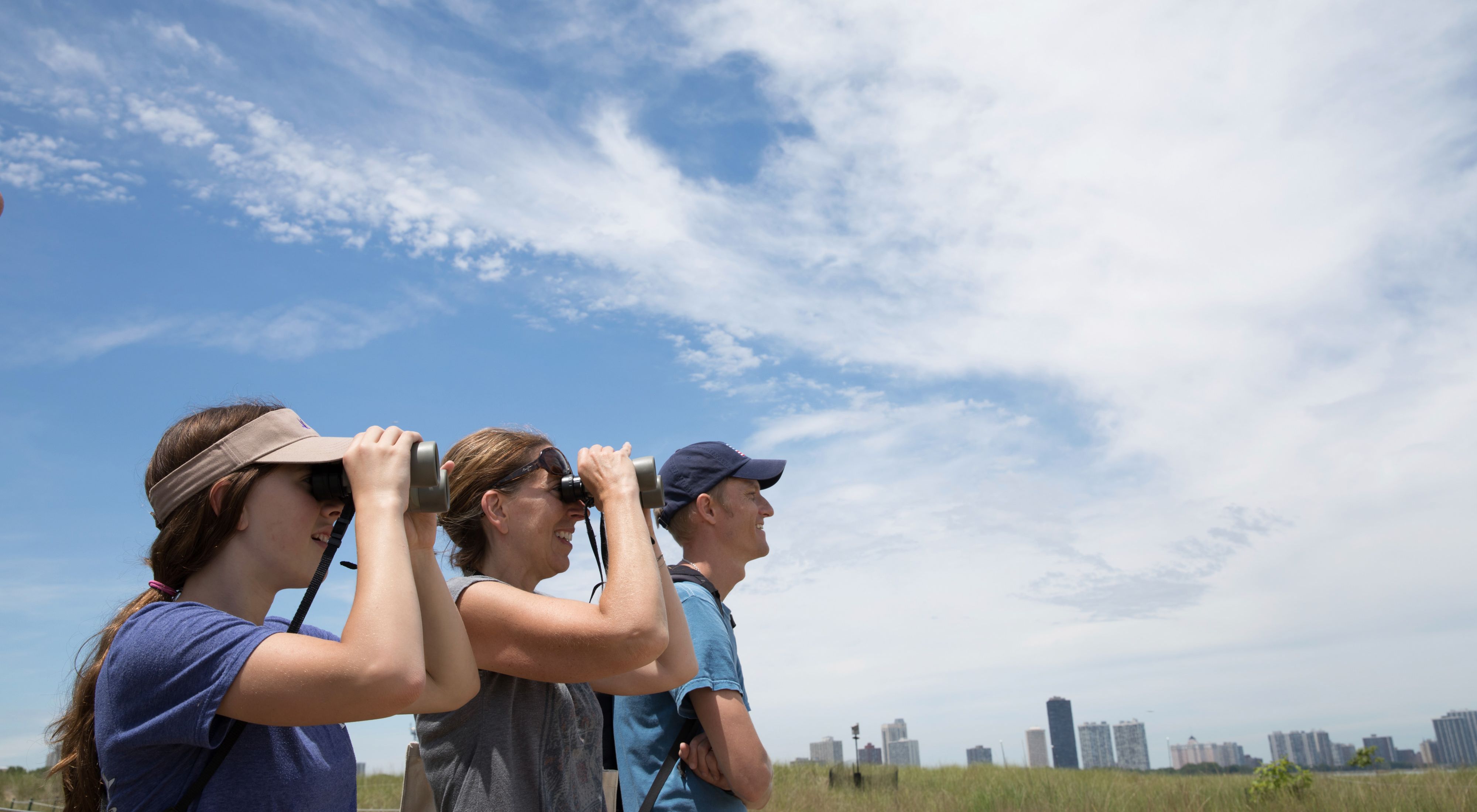Viva Volunteers
Each year thousands of TNC volunteers plant, pull, guide, count, collect, monitor and otherwise help keep nature healthy and wild.
Summer 2018
Behind every success story at The Nature Conservancy stands a crew of volunteers. They are the stewards who plant seeds and repair trails. They are the citizen scientists who count birds and learn frog calls. They are the myriad advocates who serve as TNC chapter trustees in each state and who speak up for nature at town halls, in board rooms and even on Capitol Hill.
Their impact is tangible: Unlike many other environmental organizations, TNC deploys volunteers to help it with hands-on, long-term projects on the ground and in the water. The volunteer work can be as simple as greeting visitors at TNC preserves or as complex as tracking imperiled species over a decade or two. Taken together, these efforts keep vital natural systems healthy. What’s more, the projects benefit surrounding communities—and reward volunteers themselves with satisfying evidence that their labor makes a difference.
Aaron Tjelmeland, who directs TNC’s Upper Coast Project in Texas, has seen this fi rsthand while working with volunteers to restore a coastal prairie. Bit by bit, they are together bringing back one of the rarest habitats in North America. “To be able to plant a seed on the edge of a prairie, and then track that area over time and watch the tallgrass prairie grow, you get to see how your efforts fit into the bigger picture,” he says.
More than 75,000 volunteers have worked at TNC projects around the globe in more than 70 countries and territories. In the United States, they have helped create and maintain a system of more than 400 private TNC preserves.
“Volunteers are the backbone of our preserves,” Tjelmeland says. Even though some TNC projects require hours of travel simply to get to the remote sites, and others can be physically grueling, many people get hooked on this volunteering for life. “Being out there in nature, doing the work … it’s enriching. Once people try it, they love it and they come back,” says Tjelmeland.
Find a TNC volunteer opportunity near you.
NATURAL AMBASSADORS
Oregon
There was a point in the 1960s when Cascade Head, a 270-acre preserve on Oregon’s rugged coast, was put up for sale and purchased by a developer. Concerned about the headland’s future, local citizens organized, made a deal with the owner and raised the funds for The Nature Conservancy to buy the land in 1966. Today, volunteers still play a large part in the success of Cascade Head, which is a mix of forest, grassland and cliffs overlooking the Pacific Ocean that provides critical habitat for native prairie grasses, wildflowers and the threatened Oregon silverspot butterfly.
“We go to great extremes to try to encourage these butterflies,” says Steve Springer, who, along with his wife, Barbara, has been a volunteer naturalist at the preserve for more than eight years. Volunteers like the Springers have been working with ecologists to restore patches of early blue violets to feed the butterfly’s caterpillars. They’ve even been involved in the process of reintroducing captive-bred silverspots to the preserve. But the Springers spend most of their time serving as naturalists, hiking the preserve and talking with visitors. Cascade Head is staffed with volunteer naturalists every weekend and holiday from mid-April through early October, and the Springers cherish their half a dozen weekends working here each year.
“It’s a great excuse to go to Cascade Head and do more than just hike for our personal pleasure,” Barbara says. “We take pruners for the blackberry bushes that encroach on the trail. We talk to people. It’s exciting to represent the Conservancy.”
“It’s a steep climb to the top of the preserve, where there’s a grassy knob with a great view of the ocean,” Steve says. “From the top, you feel like you could just take off and fly into space.”

URBAN NESTING
Illinois
Plenty of birds take a traditional approach to nesting, pulling twigs and leaves together into a comfy bowl in a tree, but the purple martins that migrate through the U.S. Midwest prefer to reproduce in condos. The birds are a colony nesting species that needs multiple cavities at a single site to successfully breed. But because of human development along migratory flyways, purple martins east of the Mississippi River nest almost exclusively in built birdhouses. Imagine a bird hotel.
“It’s an interesting species because they prefer to nest close to people and near water,” says Forrest Cortes, The Nature Conservancy’s community stewardship program manager in Chicago. “There are fewer predators and plenty of food.”
And that has made the city of Chicago an important breeding ground. The Conservancy supports a Chicago Park District program that uses volunteers to oversee multiple purple martin colonies around the city. The volunteers take care of the houses and count the nesting pairs of purple martins each season between March and August. Volunteers also track the number of eggs laid and hatched, and how many birds fledge. They monitor the colonies during extreme weather to ensure the birds are safe, and sometimes supplement the birds’ diets with mealworms during cold snaps. Often these caretakers find themselves in the role of ambassadors, explaining to passing park visitors the importance of nurturing the purple martin colonies.
“It’s satisfying to see the faces of these city kids when I show them the little chicks, ... barely the size of your fingernail,” says Michael Karagianis, who’s been a purple martin monitor for 10 years. “Most of these kids have never seen a wild bird up close and personal.”

SEED SAVERS
Nebraska
The Nature Conservancy's Platte River Prairies complex covers several thousand acres along Nebraska’s wide and flat Platte River. Here, TNC has restored about 1,500 acres of cropland to highly diverse prairie in an effort to enlarge and reconnect such habitats. The area is part of a critical flyway for migratory birds, particularly sandhill cranes and the endangered whooping crane. The birds use the restored prairies as a crucial refueling station.
“Sandhill cranes will spend their nights standing in the middle of the Platte to avoid predators, then fly to nearby cornfields or prairie fields for food,” says volunteer Steven Schafer, who organizes more than a dozen prairie workdays each year. “They’ll spend a week or longer in this area, eating and building up their fat supplies before continuing migration to Canada.”
The Conservancy restores the prairie using an especially diverse mix of seed that includes up to 200 different native plant species. Volunteers harvest the seeds from existing grasslands and replant them under the direction of TNC staff.
Beyond the satisfaction of helping restore the ecosystem, Schafer relishes the opportunity to be in the prairie. “I love the long horizons and the subtleties of the land,” he says. “You think prairies are fl at, but there’s just enough undulation to lose sight of people on a workday. You’ll look up from collecting seeds and have this great open prairie all to yourself.”

OYSTER NANNIES
New Hampshire
It's hard to overestimate the importance of the oyster to New Hampshire’s Great Bay. Some call the 6,000-acre tidal estuary the “hidden coast” because it’s isolated from the Atlantic but fed saltwater twice daily by tides flowing up the Piscataqua River.
In 1993, some 25 million oysters helped filter Great Bay’s waters, removing sediment and improving water clarity. But by 2000 the effects of disease, excess sediment and overharvesting had reduced the oyster population to just 1.2 million. To reverse that trend, The Nature Conservancy is rebuilding oyster reefs, seeding them with juveniles raised by volunteer oyster conservationists.
Each year, up to 300 volunteers, nicknamed oyster nannies, monitor cages hung off docks and moorings along the bay. Each cage contains roughly 1,000 of the juvenile oysters, barely large enough to see with the naked eye, attached to recycled oyster shells. The nannies clean the shells, remove crabs from the cages and collect growth data using calipers that measure to the millimeter. After a 10-week growing season, the young oysters are big enough to be placed on a restored reef within the bay—something the volunteers help with as well.
“It’s like a big celebration, putting these oysters back in the water,” says Amanda Moeser, who coordinated the program in 2017. So far, TNC and its volunteers have restored more than 20 acres of reef and put 3.5 million oysters back in the bay.
“There’s no way a single person could grow that many oysters or collect that much data,” Moeser says. “It shows what you can accomplish when everyone works for a common goal.”
